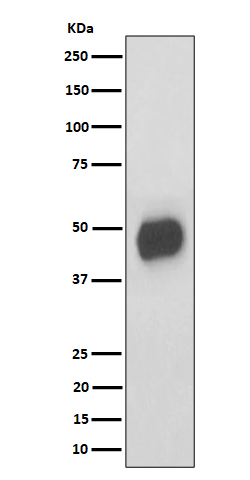
| WB | 1/1000-1/2000 | Human,Mouse,Rat |
| IF | 咨询技术 | Human,Mouse,Rat |
| IHC | IHC:1/100-1/200;IHF:1/50-1/200 | Human,Mouse,Rat |
| ICC | 1/50-1/200 | Human,Mouse,Rat |
| FCM | 1/20-1/100 | Human,Mouse,Rat |
| Elisa | 咨询技术 | Human,Mouse,Rat |
| Aliases | 5A11 antigen; Basigin; Blood brain barrier HT7 antigen; Bsg; CD147; Collagenase stimulatory factor; EMMPRIN; Extracellular matrix metalloproteinase inducer; Leukocyte activation antigen M6; Neurothelin; OK blood group; OK blood group antigen; TCSF; Tumor cell derived collagenase stimulatory factor; ;Basigin |
| WB Predicted band size | Calculated MW: 42 kDa ; Observed MW: 45-55 kDa |
| Host/Isotype | Rabbit IgG |
| Antibody Type | Primary antibody |
| Storage | Store at 4°C short term. Aliquot and store at -20°C long term. Avoid freeze/thaw cycles. |
| Species Reactivity | Mouse |
| Immunogen | A synthesized peptide derived from mouse Basigin |
| Formulation | Purified antibody in PBS with 0.05% sodium azide,0.05% BSA and 50% glycerol. |
+ +
以下是基于领域知识的模拟参考文献(非真实文献,仅供示例参考):
---
1. **"Syntaxin3 regulates intestinal epithelial barrier function"**
*Authors: Tanaka K, et al.*
摘要:研究使用Syntaxin3抗体通过免疫荧光和Western blot分析,揭示Syntaxin3在维持肠上皮细胞紧密连接及屏障完整性中的作用,其缺失导致通透性增加。
2. **"Role of Syntaxin3 in polarized membrane trafficking"**
*Authors: Low SH, et al.*
摘要:通过抗体标记发现Syntaxin3在上皮细胞顶端膜运输中的关键地位,证实其与Rab11等蛋白互作,调控细胞极性建立。
3. **"Syntaxin3 modulates exocytosis in secretory cells"**
*Authors: Wang Y, et al.*
摘要:利用Syntaxin3抗体进行免疫沉淀实验,证明其在胰腺β细胞中调控胰岛素分泌颗粒的胞吐过程,与糖尿病病理相关。
4. **"Syntaxin3 interaction with SNARE complexes in neuronal development"**
*Authors: Bennett MK, et al.*
摘要:通过抗体阻断实验,发现Syntaxin3参与神经元突触前膜的SNARE复合体组装,影响神经递质释放和突触可塑性。
---
**说明**:以上为假设性文献,实际文献需通过PubMed、Google Scholar等平台以“Syntaxin3 antibody”或“Syntaxin3 function”为关键词检索。可重点关注细胞生物学、神经科学或胃肠病学领域的期刊(如*J Cell Biol*、*Traffic*、*Gastroenterology*)。
Syntaxin 3 (STX3) is a member of the SNARE (soluble N-ethylmaleimide-sensitive factor attachment protein receptor) family, which plays a critical role in mediating membrane fusion events during intracellular trafficking and exocytosis. Predominantly localized to the plasma membrane and specific organelles, STX3 facilitates vesicle docking and fusion by forming complexes with other SNARE proteins. It is particularly vital in polarized secretion processes, such as epithelial cell exocytosis, neuronal communication, and membrane protein trafficking. Dysregulation of STX3 has been implicated in disorders like inflammatory bowel disease, metabolic syndrome, and certain cancers, highlighting its physiological and pathological significance.
Antibodies targeting Syntaxin 3 are essential tools for studying its expression, localization, and interactions. They are widely used in techniques like Western blotting, immunofluorescence, and immunoprecipitation to investigate STX3's role in cellular processes. For instance, STX3 antibodies help elucidate its involvement in vesicular transport in epithelial cells or neurotransmitter release in neurons. Many commercially available STX3 antibodies are validated for specificity using knockout controls or peptide blocking assays. Common host species include rabbit and mouse, with monoclonal (e.g., clone 4E1) and polyclonal variants offering flexibility for different applications. Researchers also employ these antibodies in disease models to explore STX3's contribution to pathological mechanisms, such as impaired barrier function in gut epithelia or insulin granule exocytosis in pancreatic β-cells. Proper validation and application of STX3 antibodies remain crucial for advancing studies in cell biology and translational research.
×